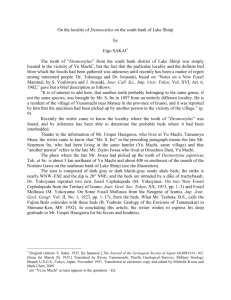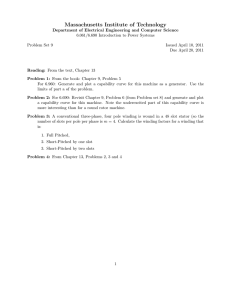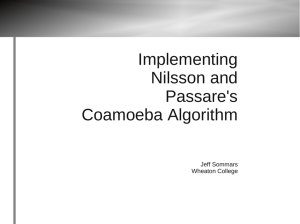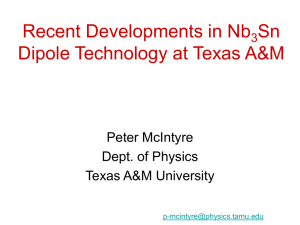MASSACHUSETTS INSTITUTE OF TECHNOLOGY DEPARTMENT OF MECHANICAL ENGINEERING DEPARTMENT OF NUCLEAR ENGINEERING
advertisement
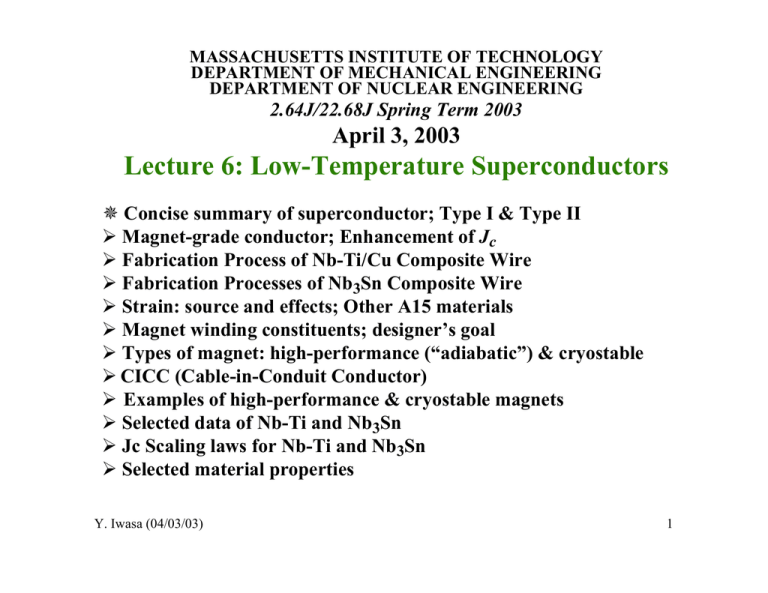
MASSACHUSETTS INSTITUTE OF TECHNOLOGY DEPARTMENT OF MECHANICAL ENGINEERING DEPARTMENT OF NUCLEAR ENGINEERING 2.64J/22.68J Spring Term 2003 April 3, 2003 Lecture 6: Low-Temperature Superconductors Concise summary of superconductor; Type I & Type II ¾ Magnet-grade conductor; Enhancement of Jc ¾ Fabrication Process of Nb-Ti/Cu Composite Wire ¾ Fabrication Processes of Nb3Sn Composite Wire ¾ Strain: source and effects; Other A15 materials ¾ Magnet winding constituents; designer’s goal ¾ Types of magnet: high-performance (“adiabatic”) & cryostable ¾ CICC (Cable-in-Conduit Conductor) ¾ Examples of high-performance & cryostable magnets ¾ Selected data of Nb-Ti and Nb3Sn ¾ Jc Scaling laws for Nb-Ti and Nb3Sn ¾ Selected material properties Y. Iwasa (04/03/03) 1 Critical Field vs. Temperature Plots of “Magnet” Superconductors µ˚Hc2 [ T ] HTS: YBCO; BSCCO; MgB2 150 LTS: Nb-Ti; Nb3Sn YBCO BSCCO 2223 100 BSCCO 2212 50 Nb3Sn MgB2 NbTi 0 0 Y. Iwasa (04/03/03) 20 40 60 80 100 T [K] 2 Concise Summary Superconductivity discovered by Kamerlingh-Onnes, 1991. Type I (soft) superconductors: Hg, Pb, In. Critical properties: Tc; Hc; Jc. Meissner effect: perfect diamagnetism. Penetration depth (London theory, 1935). m λ= µ o e 2 ne 2 ρN A ne = WA Superelectrons: Copper pair. Y. Iwasa (04/03/03) 3 Concise Summary (continued) Discovery of Type II (hard) superconductors: Pb-Bi (1930). Penetration of H in Type II (Mixed state)--new model. Vortex model (Abrikosov): normal vortex in super conducting sea. Coherehnce (transition) length: ξ Type I: ξ ⟩ 2 λ Type II: ξ ⟨ 2 λ Coherence length affected by alloying. Alloying increases resistivity: ξ ∝ 1/ρ and Tc ∝ ρ. Normal state ρsc of Type II: 102–103 greater than ρcu. Y. Iwasa (04/03/03) 4 Selected Type I Superconductors Material (Type) Ti (metal) Zn Al In Sn Hg V Pb Tc [K] 0.40 0.85 1.18 3.41 3.72 4.15 5.40 7.19 µoHco* [T] 0.0056 0.0054 0.0105 0.0281 0.0305 0.0411 0.1403 0.0803 *0K Y. Iwasa (04/03/03) 5 Selected Type II Superconductors Tc [K] µoHco [T] Nb (metal) 9.5 0.2* Nb-Ti (alloy) 9.8 NbN (metalloid) 16.8 Nb3Sn (intermetalic compound: A15) Nb3Al Nb3Ge 18.3 18.7 23.2 10.5† 15.3† 24.5† 31.0† 35.0† MgB2 (compound) 39 ~15* YBa2Cu3-xOx (oxide: Perovskite) <YBCO> Bi2Sr2Cax−1CuxO2x+4 <BSCCO2223 or 2212> 93 110 150* 108* Material (Type) * 0 K † 4.2 K Y. Iwasa (04/03/03) 6 A-15 (β-W ) Structure Nb (6/cube) Sn (2/cube): Nb3Sn Y. Iwasa (04/03/03) 7 Materials vs. Magnet-Grade Conductors Criterion Number Discipline 1. Superconductivity? ~10,000* Physics 2. Tc>10 K (µoHco>10 T)? ~100* Physics 3. Jc>1 MA/cm2 (@ B>5 T)? ~10* metallurgy 4. Magnet-grade superconductor? ~1* metallurgy * Order of magnitude Y. Iwasa (04/03/03) 8 Magnet-Grade Conductors Satisfies rigorous specifications required for use in a magnet. Readily available commercially. Currently, only three: Nb-Ti; Nb3Sn; BSCCO2223 R&D Stage: BSCCO2212 (NMR); YBCO (Electric devices); Nb3Al (limited interest for Fusion & NMR) Promising: MgB2 (cost said to be comparable with Nb-Ti) Y. Iwasa (04/03/03) 9 Material-to-Conductor Development Stages —Nb3Sn — Stage Event Period 1 Discovery Early 1950s 2 Improvement Jc Early 1960s 3 Co-processing with matrix metal Mid 1960s 4 Multifilament/twisting, Ic>100 A Early 1970s 5 Long length, typically ~1 km Mid 1970s 6 Full specifications for magnets Late 1970s Y. Iwasa (04/03/03) 10 Enhancement of Jc Of the three critical parameters—Hc, Tc, Jc—Jc may be improved by metallurgical processing. Alloying enhances “flux pinning” which increases Jc. Force on vortex: Fv = J c × µo H Pinning of vortices: 1) crystal impurities – small crystals, grain boundary densities, dislocation density; 2) creation of artificial pinning sites by cold working, heat treatment. Y. Iwasa (04/03/03) 11 Schematic drawing of “pinned” vortices Magnetic Flux Lines Grain Boundaries/ Structural Defects Pinned Vortex Current Supercurrent Supercurrent Y. Iwasa (04/03/03) 12 Heat Treatment Window of opportunity—dependent on composition. Trade-off between grain size and boundary growth. Time/temp for heat treatment (Nb-Ti: 390˚C/~100 h). HT time must be “reasonable” for the plant (<100 h). Y. Iwasa (04/03/03) 13 Effects of cold work and heat treatment on Jc Y. Iwasa (04/03/03) 14 Cold Working (Drawing) Increase dislocation density (increased Jc). Experimental evidence of increased Jc with smaller grain size: true for every known superconductor Y. Iwasa (04/03/03) 15 Fabrication Process of Nb-Ti/Cu Composite Wire Extrusion of Nb-Ti billet co-processed with copper. Low-resistance path during transition to the normal state. Mechanical strength and ductility. Y. Iwasa (04/03/03) 16 Production of MF Nb-Ti/Cu Composite Stage 1: Stacking & Hexagonal Nb-Ti/Cu Rod Preheat Cu Extrusion Can Extrude Evacuate & Seal Nb-Ti Billet (10-25 cmφ; 15-200 kg) Nb-Ti/Cu Hexagonal Rod Y. Iwasa (04/03/03) Nb-Ti/Cu Rod 17 Nb-Ti (continued) Multifilamentary wire Flux jumping: filament size (<critical size) Increased grain boundary density. Cold drawing and heat treatment (repeated). Twisting: strain limits—pitch length 5-15 times wire dia. Anneal Cu and insulate. Y. Iwasa (04/03/03) 18 Stage 2: MF Composite Evacuate & Seal Stacking Nb-Ti/Cu Hex Rods (10-25 cmφ; 15-200 kg) Preheat & Extrude MF Rod MF Wire Y. Iwasa (04/03/03) Cold Draw 19 Stage 3: Twisting & Spooling Twist Heat Treat Anneal Spool Y. Iwasa (04/03/03) Test Insulate 20 Courtesy of Claude Kohler (ALSTOM, Belfort) Y. Iwasa (04/03/03) 21 Fabrication Processes of Nb3Sn Wire Five processes Bronze External diffusion Internal Sn Nb Tube & Sn Tube Jelly Roll & Modified Jelly Roll Y. Iwasa (04/03/03) 22 Bronze Diffusion: Sn into Nb Parameters: 700˚C, 1-10 days (max. diff. 5-10 µm). Cu: prevents Nb6Sn5 from forming; a catalyst Temperature: good stoichiometry vs. small grains Bronze: 16wt.%Sn max. >13% makes drawing difficult Maximum Nb3Sn:~25wt.% Addition of Cu: ~103 better electrically/thermally than bronze Con: Sn diffuses more easily into Cu than Nb Diffusion barrier, e.g., Ta, to maintain Cu purity Cu-Sn Nb Y. Iwasa (04/03/03) 23 External Diffusion Pros: 1) Draw first, then plate with Sn (bronze is hard to draw); No intermediate annealing necessary 2) >13 wt.%Sn possible, yielding higher Jc Cons: 1) Thick layer of (>~5 µm) of Sn tend to delaminate; 2) Sn melts at 230˚C, while reaction temp ~700˚C 3) Hard to use with Ta and pure Cu Cu Nb Sn Y. Iwasa (04/03/03) 24 Internal Sn Pros: 1) Nb intermediate anneal for bronze 2) Cu and Ta can easily be added 3) As with external diffusion, higher Jc Cons: 1) Sn concentration limited 2) Extrusion of billet problems Sn Cu Nb Y. Iwasa (04/03/03) 25 Nb Tube Pros: 1) Nb3Sn close to Cu stabilizer 2) Nb acts as a diffusion barrier for Sn (Ta unnecessary) Cons: 1) Limit to minimum filament size (AC losses) 2) Because of Nb tubes, process costly Nb Cu-Sn Cu Y. Iwasa (04/03/03) 26 Jelly Roll and MJR Pros: 1) No intermediate anneal 2) Cu and Ta easily wrapped in roll 3) Other trace materials can easily be added to core to improve properties Cu-Sn Sheet Nb Sheet Cu Y. Iwasa (04/03/03) 27 Other A15 Materials V3Ga Inferior to Nb3Sn in Tc and Hc2, but better Jc Can be processed similar to bronze process Cons: 1) Reaction at 500˚C for 500 h 2) More brittle than Nb3Sn Nb3Al Fabrication difficulties; no bronze process equivalent exists Bulk Nb3Al requires HT at >1500˚C, leading to large grain boundaries and other unwanted Al-rich compounds MJR proven quite successful in making multifilamentary composite Y. Iwasa (04/03/03) 28 6. Strain: Source and Effects Fabrication temperature to operating temperature: strain from mismatch in thermal expansion (contraction) coefficients Winding magnet: winding radius limitation winding strain = wire dia./winding i.d. Lorentz forces Strain generally degrades Jc Treat Nb3Sn as you would glass Nb3Sn damaged for strains beyond ~0.7% Y. Iwasa (04/03/03) 29 Strain Effect on Jc: Nb-Ti Y. Iwasa (04/03/03) 30 Strain Effect on Jc: Nb3Sn Y. Iwasa (04/03/03) 31 Magnet Winding Constituents Magnet winding generally comprises of: Superconductor—Nb-Ti, Nb3Sn, or BSCCO2223 Electrically conductive normal metal for stability and protection— Cu, Al, or Ag High-strength metal for mechanical integrity—high-strength metal, or work-hardened Cu also used as stabilizer. Coolant Y. Iwasa (04/03/03) 32 Designer’s Goal Maximize overall (or engineering) current density, Jover (or Je), and still satisfying requirements of: Stability; protection; mechanical integrity; and cost — for commercially viable units Y. Iwasa (04/03/03) 33 Types of Magnet Basically there are two types of magnet: I. High-performance (“Adiabatic”) II. Cryostable Y. Iwasa (04/03/03) 34 I. High-performance Jover enhanced by: Combining superconductor and high-strength normal metal (stability; protection; mechanical). Eliminating local coolant* and impregnating the entire winding space unoccupied by conductor with epoxy, making the entire winding as one monolithic structural entity. (Presence of cooling in the winding makes the winding mechanically weak and takes up the conductor space.) High-performance approach universally used for NMR, MRI, HEP dipoles & quadrupoles in which R×J×B manageable with a combination of “composite conductor” & “monolithic entity.” * The conductor always requires cooling but not necessarily exposed directly to the coolant. Y. Iwasa (04/03/03) 35 “Adiabatic” Windings 1. Bath Cooled Winding immersed in a bath of cryogen Work-hardened stabilizer or reinforcement added Examples: NMR; MRI Epoxy Impregnation Cryogen (He, N2) Coil Form Y. Iwasa (04/03/03) 36 “Adiabatic” Windings (Continued) 2. Forced-Flow Cryogen Winding “globally” cooled by forced-flow single-phase cryogen Work-hardened stabilizer or reinforcement added Examples: HEP diploes & quadrupoles Cryogen forced through pipe Y. Iwasa (04/03/03) 37 “Adiabatic” Windings (Continued) 3. Cryocooler-cooled Winding conduction cooled by a cryocooler Work-hardened stabilizer or reinforcement added Examples: “Dry” research-purpose magnets (up to 15 T) Cryocooler Y. Iwasa (04/03/03) 38 II. Cryostable Characterized by the presence of local or “near-local” cooling. Nearly universally adapted winding configuration for those magnets that must “guarantee” performance. These include “large” research-purpose high-field magnets, e.g., MIT Hybrid III, and those that are key components of the experimental devices, e.g., fusion. There are two types of cryostable magnets: 1. Magnets with “small” R×J×B (and o.d. typically <1 m), “composite conductor,” i.e. combination of superconductor and work-hardened normal metal (stability; protection; mechanical), sufficient to meet mechanical requirements despite the presence of coolant space. 2. Magnets with “large” R×J×B (and o.d. typically >1 m), e.g., Fusion magnets, “composite conductor,” no longer sufficient to meet mechanical requirements; CICC (cable-in-conduit conductor) or reinforced composite/forced cooling. Y. Iwasa (04/03/03) 39 Cryostable Winding 1. Cryogen Well-Ventilated within Winding Work-hardened stabilizer Examples: Many “large” magnets of the 1960s-1990s, including MIT 35-T Hybrid; LHD TF coil Turn-to-turn segment occupied by insulating spacers Cryogen Segment not occupied by insulating spacers Y. Iwasa (04/03/03) 40 Cryostable Winding (Continued) 2. CICC (Cable-in-Conduit Conductor) Single-phase cryogen forced through conduit that contains cabled Superconductor/stabilizer composite Conduit (steel alloy) reinforces the conductor Examples: Most fusion magnets; NHMFL 45-T hybrid Forced single-phase cryogen Conduit Y. Iwasa (04/03/03) 41 Cryostable Winding (Continued) 3. Reinforced Composite & Forced-Flow Single-Phase Cryogen Single-phase cryogen forced through a set of pipes placed near the winding comprises of reinforced composite Example: CMS magnet of the LHC Reinforced composite Single-phase cryogen Y. Iwasa (04/03/03) 42 CICC Cabled strands of superconductor encased in a conduit, which provides mechanical strength and through which single-phase cryogen (generally helium) is forced to provide cooling to the superconductor Advantage Integrates key requirements of a superconductor—current-carrying capacity; stability & protection; AC losses; mechanical integrity—in a single conductor configuration. Disadvantage Because of the non-current carrying space occupied by the conduit and cryogen, Iop should be "large" to keep Jover "reasonable.” Generally, Iop >10 kA; occasionally Iop> a few kA. Suitable Applications "High" field and "large" volume magnets, i.e., fusion; SMES. Y. Iwasa (04/03/03) 43 Transposed 37-Strand Cable (c. 1970) Courtesy of Luca Bottura (CERN, Geneva) Y. Iwasa (04/03/03) 44 Tube-Mill Fabrication of CICC Y. Iwasa (04/03/03) 45 28 mm 56 mm Y. Iwasa (04/03/03) 46 ITER CICC Y. Iwasa (04/03/03) 47 CICC (50 mm x 50mm) Strand (0.81 mm diameter) Y. Iwasa (04/03/03) 48 EURATOM Large Coil Test (LCT) Conductor (c. 1980s) Rutherford Cable soldered to insulated SS core MF Nb-Ti/Cu composites Y. Iwasa (04/03/03) Conductor force-cooled by Supercritical He SS Jacket seam-welded 49
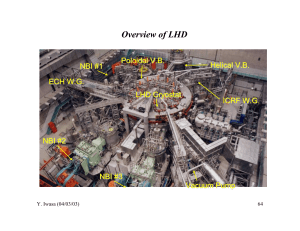

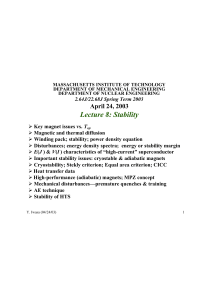
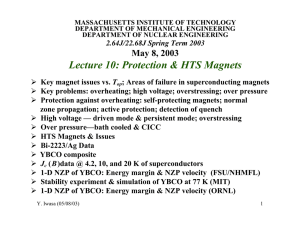
![FORM NO. 157 [See rule 331] COMPANIES ACT. 1956 Members](http://s3.studylib.net/store/data/008659599_1-2c9a22f370f2c285423bce1fc3cf3305-300x300.png)
